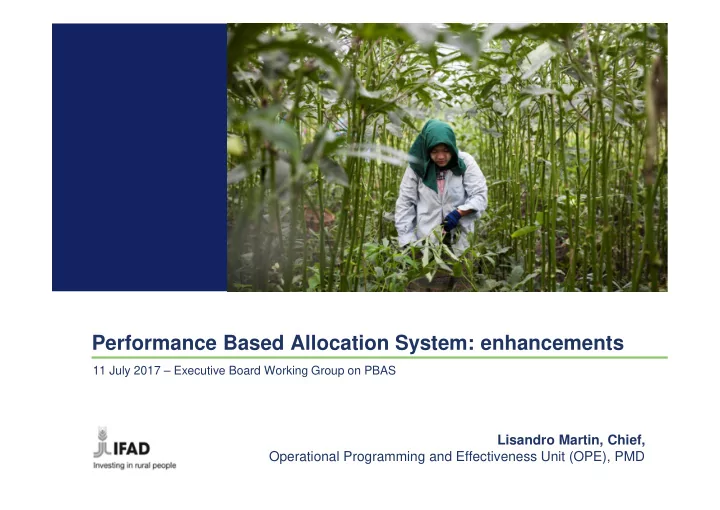

Performance Based Allocation System: enhancements 11 July 2017 – Executive Board Working Group on PBAS Lisandro Martin, Chief, Operational Programming and Effectiveness Unit (OPE), PMD
Today’s presentation Proposed scenarios slide: 3 - 9 IFAD11 and beyond slide: 10 - 12 Q&A slide: 13 2
Scenarios A more balanced and stable formula… A B C D Needs Needs Needs Needs Scenario 3 Scenario 3 Scenario 3 Scenario 3 49% 49% 55% 54% 51% 51% 46% 45% Performance Performance Performance Performance High dispersion of High dispersion of High dispersion of Lowest dispersion allocations of allocations allocations allocations 27% of countries with 26% of countries with 44% of countries with 10% of countries with minimum allocations minimum allocations minimum allocations minimum allocations Focus on GNIpc and Balanced elasticity PAD: formula prone to across variables volatility 3
Scenarios …that strengthens the focus on the poorest countries. Performance Performance Proposed IFAD10 scenario 35% 45% Scenario Scenario 65% 55% Needs Needs MFS, MFS, 22% 31% LICS, UMICS, 32% 19% UMICS, Total resources LICS, 15% 41% LMICS, LMICS, 44% 49% 4
Scenarios The proposed scenario’s ability to capture the multidimensionality of poverty… Share of allocation by indicator by two top quintiles (Total resources) HDI Agri GDP 60% 56% Djibouti 50% Grenada 47% PROPOSED SCENARIO + 54% + 50% 40% 30% 22% 19% Liberia Gambia 20% IFAD10 + 39% + 36% 10% 0% Agricultural GDP Human Development Index 5
Scenarios …is confirmed by diverse measures. Share of allocation by indicator by two top quintiles (Total resources) School Infant enrolment mortality 60% 57% 50% 47% Chad Niger 44% PROPOSED SCENARIO + 64% + 53% 37% 40% 30% 20% Guinea Cameroon IFAD10 + 25% + 46% 10% 0% Infant mortality School enrolment 6
Scenarios IFAD11 cross-cutting priorities are adequately captured Share of allocation to countries with lower performance by two top quintiles (Total resources) 70% 60% 60% 55% 54% PROPOSED SCENARIO 50% 46% 46% 40% 40% 30% 30% 25% 20% IFAD10 10% 0% Gender Youth Nutrition Climate 7
Scenarios Most resources are concentrated on countries that need the most and perform the best IFAD10 IFAD11 Current Proposed Needs Quintiles Needs Quintiles 6 6 5 3 3 1 1 1 5 3 2 0 2 1 Performance Quintiles Performance Quintiles 4 9 6 4 1 0 4 7 6 3 2 0 3 14 4 4 1 1 3 9 1 3 1 2 2 6 2 3 3 2 2 15 6 6 1 17 6 4 4 0 15 9 4 2 0 1 1 0 0 0 1 2 3 4 5 6 0 1 2 3 4 5 6 8
Scenarios Balanced elasticity across variables Comparison of elasticities – current and proposed formula 18% Scenario proposed Needs Performance POP IFAD10 19% -15% GNI -10% 47% IVI CPIA 26% 18% RSP 33% 33% PAR/PAD 31% -20% -10% 0% 10% 20% 30% 40% 50% 60% 9
IFAD11 and IFAD11 Business Model provides the beyond strategic direction, with no uncertainties Business Model IFAD11 IFAD11 country selectivity criteria preserve the formula’s macro-stability The proposed PBAS allows IFAD to maintain its commitment on shares of allocations of core resources (90% to LICS and LMICS, 10% to UMICS). The size of the PoLG (3.3, 4, 4.5) does not influence the PBAS allocation shares by income level, lending term or any other breakdown. Therefore, the PBAS would remain valid for any PoLG level. 10
IFAD11 and Different sources of funding require beyond different resource allocation systems Beyond IFAD11 Bond issuance is a tool for increasing IFAD’s The PBAS is a mechanism for the fair funding base at cheap funding costs thorough distribution of resources to neediest and best high credit rating performing countries To obtain a high credit rating allocations of loan Allocations are determined by the formula portfolio funded by bonds must be driven by risk management considerations: Single borrower concentration Recipient countries are allocated financing regardless of their creditworthiness Borrower credit rating 11
IFAD11 and Way forward: preparing for IFAD11 beyond and beyond IFAD10 IFAD11 IFAD12 2017 2019 2022 2024 2018 2020 2021 2023 Q4 2017 2022 Q1 2019 – Q4 2020 • Inaugural bond issue • Feasibility study on market borrowing • Formal rating process • Internal rating assessment begins • Production of PBAS Manual • Revised RSP testing Q1-Q2 2018 Q1-Q4 2020 • Development of PBAS IT system • Review of PBAS Q2 2018 • IVI data collection and production • RSP scores production • PAD production • IFAD11 PBAS allocations Q3 2018 – Q2 2020 • Definition of IFAD approach to loan pricing 12
Any questions? Thank you for your attention
0.00 1.00 2.00 3.00 4.00 5.00 6.00 Armenia Assessment Testing the new Rural Sector Performance Bosnia and Herzogovina WHAT HOW WHY Egypt lower, with an average reduction of 3% The new RSP scores countries slightly Reduced repetition between indicators RESULTS Iraq Kazakhstan Lebanon Montenegro Sudan Tajikistan Turkey Yemen Botswana Comoros use current RSP, CPIA, and other data sources to score countries assess the potential impact of newly made scores on allocations mock scoring of countries with the new questionnaire Ethiopia Lesotho Malawi Mozambique Rwanda South Africa Swaziland Uganda Zimbabwe Bangladesh Cambodia Cook Islands India Iran D.P.R.K. Malaysia Marshall Islands Myanmar Nepal Pakistan Philippines Solomon Islands Thailand Tonga Vanuatu Argentina Bolivia Colombia Domincan Republic El Salvador Guatemala on allocations Limited impact Honduras Nicaragua Peru beyond IFAD11 and Guyana Venezuela Benin Cameroon RSP last Central African Republic Congo DR Côte d’Ivoire Gabon Ghana Guinea Bissau RSP new Mali Niger Sao Tome 14 Sierra Leone
Recommend
More recommend